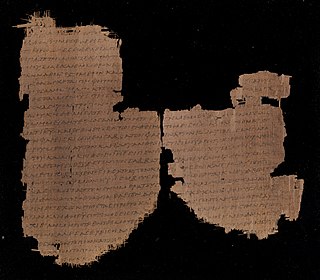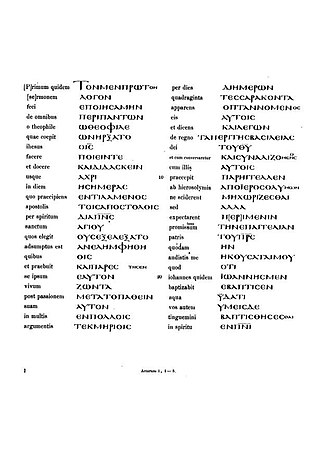
The Acts of the Apostles is the fifth book of the New Testament; it tells of the founding of the Christian Church and the spread of its message to the Roman Empire.

The Gospel of Mark is the second of the four canonical gospels and one of the three synoptic Gospels. It tells of the ministry of Jesus from his baptism by John the Baptist to his death, the burial of his body, and the discovery of his empty tomb. It portrays Jesus as a teacher, an exorcist, a healer, and a miracle worker, though it does not mention a miraculous birth or divine pre-existence. He refers to himself as the Son of Man. He is called the Son of God but keeps his messianic nature secret; even his disciples fail to understand him. All this is in keeping with the Christian interpretation of prophecy, which is believed to foretell the fate of the messiah as suffering servant.

The Gospel of Luke tells of the origins, birth, ministry, death, resurrection, and ascension of Jesus. Together with the Acts of the Apostles, it makes up a two-volume work which scholars call Luke–Acts, accounting for 27.5% of the New Testament. The combined work divides the history of first-century Christianity into three stages, with the gospel making up the first two of these – the life of Jesus the Messiah from his birth to the beginning of his mission in the meeting with John the Baptist, followed by his ministry with events such as the Sermon on the Plain and its Beatitudes, and his Passion, death, and resurrection.

The Gospel of John is the fourth of the New Testament's four canonical gospels. It contains a highly schematic account of the ministry of Jesus, with seven "signs" culminating in the raising of Lazarus and seven "I am" discourses culminating in Thomas's proclamation of the risen Jesus as "my Lord and my God". The gospel's concluding verses set out its purpose, "that you may believe that Jesus is the Christ, the Son of God, and that believing you may have life in his name."
Gospel originally meant the Christian message, but in the 2nd century it came to be used also for the books in which the message was reported. In this sense a gospel can be defined as a loose-knit, episodic narrative of the words and deeds of Jesus, culminating in his trial and death and concluding with various reports of his post-resurrection appearances.
The New Testament (NT) is the second division of the Christian biblical canon. It discusses the teachings and person of Jesus, as well as events relating to first-century Christianity. The New Testament's background, the first division of the Christian Bible, is called the Old Testament, which is based primarily upon the Hebrew Bible; together they are regarded as Sacred Scripture by Christians.

The Ascension of Jesus is the Christian belief, reflected in the major Christian creeds and confessional statements, that Jesus ascended to Heaven after his resurrection, where he was exalted as Lord and Christ, sitting at the right hand of God.

The virgin birth of Jesus is the Christian and Islamic doctrine that Jesus was conceived by his mother, Mary, through the power of the Holy Spirit and without sexual intercourse. Christians regard the doctrine as an explanation of the mixture of the human and divine natures of Jesus. The Eastern Orthodox Churches accept the doctrine as authoritative by reason of its inclusion in the Nicene Creed, and the Catholic Church holds it authoritative for faith through the Apostles' Creed as well as the Nicene. Nevertheless, there are many contemporary churches in which it is considered orthodox to accept the virgin birth but not heretical to deny it.

Marcion of Sinope was a theologian in early Christianity. Marcion preached that God had sent Jesus Christ, who was distinct from the "vengeful" God (Demiurge) who had created the world. He considered himself a follower of Paul the Apostle, whom he believed to have been the only true apostle of Jesus Christ; his doctrine is called Marcionism. Marcion published the earliest record of a canon of New Testament books.
Marcionism was an early Christian dualistic belief system that originated with the teachings of Marcion of Sinope in Rome around 144 AD. Marcion was an early Christian theologian, evangelist, and an important figure in early Christianity. He was the son of a bishop of Sinope in Pontus. About the middle of the 2nd century (140–155) he traveled to Rome, where he joined the Syrian Gnostic Cerdo.

The New Testament apocrypha are a number of writings by early Christians that give accounts of Jesus and his teachings, the nature of God, or the teachings of his apostles and of their lives. Some of these writings were cited as scripture by early Christians, but since the fifth century a widespread consensus has emerged limiting the New Testament to the 27 books of the modern canon. Roman Catholic, Eastern Orthodox, and Protestant churches generally do not view the New Testament apocrypha as part of the Bible.

Jesus, also referred to as Jesus Christ, Jesus of Nazareth, and many other names and titles, was a 1st-century Jewish preacher and religious leader. He is the central figure of Christianity, the world's largest religion. Most Christians believe Jesus to be the incarnation of God the Son and the awaited messiah, or Christ, a descendant from the Davidic line that is prophesied in the Old Testament. Virtually all modern scholars of antiquity agree that Jesus existed historically. Accounts of Jesus's life are contained in the Gospels, especially the four canonical Gospels in the New Testament. Academic research has yielded various views on the historical reliability of the Gospels and how closely they reflect the historical Jesus.

The life of Jesus is primarily outlined in the four canonical gospels, which includes his genealogy and nativity, public ministry, passion, prophecy, resurrection and ascension. Other parts of the New Testament – such as the Pauline epistles which were likely written within 20 to 30 years of each other, and which include references to key episodes in the life of Jesus, such as the Last Supper, and the Acts of the Apostles, which includes more references to the Ascension episode than the canonical gospels also expound upon the life of Jesus. In addition to these biblical texts, there are extra-biblical texts that make reference to certain events in the life of Jesus, such as Josephus on Jesus and Tacitus on Christ.
Criticism of the Bible refers to a variety of criticisms of the Bible, the collection of religious texts held to be sacred by Christianity, Judaism, Samaritanism, and other Abrahamic religions. Criticisms of the Bible often concern the text’s factual accuracy, moral tenability, and supposed inerrancy claimed by biblical literalists. There remain questions of biblical authorship and what material to include in the biblical canon.
The Gospel of Luke and the Acts of the Apostles make up a two-volume work which scholars call Luke–Acts. The author is not named in either volume. According to a Church tradition, first attested by Irenaeus, he was the Luke named as a companion of Paul in three of the Pauline letters, but "a critical consensus emphasizes the countless contradictions between the account in Acts and the authentic Pauline letters." The eclipse of the traditional attribution to Luke the companion of Paul has meant that an early date for the gospel is now rarely put forward. Most scholars date the composition of the combined work to around 80–90 AD, although some others suggest 90–110, and there is textual evidence that Luke–Acts was still being substantially revised well into the 2nd century.
The historical reliability of the Gospels is evaluated by experts who have not reached complete consensus. While all four canonical gospels contain some sayings and events that may meet at least one of the five criteria for historical reliability used in biblical studies, the assessment and evaluation of these elements is a matter of ongoing debate.
Historiography of early Christianity is the study of historical writings about early Christianity, which is the period before the First Council of Nicaea in 325. Historians have used a variety of sources and methods in exploring and describing Christianity during this time.

Traditionally in Christianity, orthodoxy and heresy have been viewed in relation to the "orthodoxy" as an authentic lineage of tradition. Other forms of Christianity were viewed as deviant streams of thought and therefore "heterodox", or heretical. This view was challenged by the publication of Walter Bauer's Rechtgläubigkeit und Ketzerei im ältesten Christentum in 1934. Bauer endeavored to rethink Early Christianity historically, independent from the views of the current church. He stated that the 2nd-century church was very diverse and included many "heretical" groups that had an equal claim to apostolic tradition. Bauer interpreted the struggle between the orthodox and heterodox to be the "mainstream" Church of Rome struggling to attain dominance. He presented Edessa and Egypt as places where the "orthodoxy" of Rome had little influence during the 2nd century. As he saw it, the theological thought of the "Orient" at the time would later be labeled "heresy". The response by modern scholars has been mixed. Some scholars clearly support Bauer's conclusions and others express concerns about his "attacking [of] orthodox sources with inquisitional zeal and exploiting to a nearly absurd extent the argument from silence." However, modern scholars have critiqued and updated Bauer's model.

Acts 1 is the first chapter of the Acts of the Apostles in the New Testament of the Christian Bible. The book containing this chapter is anonymous, but early Christian tradition affirmed that Luke composed this book as well as the Gospel of Luke. This chapter functions as a transition from the "former account" with a narrative prelude, repeated record of the ascension of Jesus Christ with more detail and the meeting of Jesus' followers, until before Pentecost.













